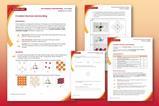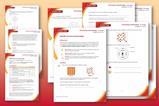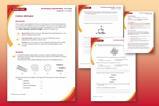Support learners to connect 2D diagrams with 3D models of ionic lattices
This worksheet is part of the Johnstone’s triangle series of resources, designed to help learners to move between different conceptual levels of thinking in key chemistry topics.
Learning objectives
- Recognise a diagram that shows the structure of sodium chloride.
- Draw electronic structure diagrams of common ions.
- Use the idea of electron energy levels to compare the size of ions.
- Interpret ionic lattice diagrams of an unfamiliar ionic compound.
How to use this resource
This resource aims to develop learners’ understanding of ionic structures. Being able to think about ions in different ways will help learners to develop their understanding of ionic structures. As a result, learners should develop more secure mental models to support their thinking about this topic.
- When to use? Use after initial teaching or discussion of this topic to develop ideas further. You can also use as a revision activity.
- Group size? Suitable for independent work either in class or at home. Or use the questions for group or class discussions.
- How long? 15–30 mins
Johnstone’s triangle
Johnstone’s triangle is a model of the three different conceptual levels in chemistry: macroscopic, symbolic and sub-microscopic. You can use Johnstone’s triangle to build a secure understanding of chemical ideas for your learners.
Introduce learners to Johnstone’s triangle with our Ionic bonding Johnstone’s triangle worksheet which demonstrates how to link the macroscopic properties of table salt to the sub-microscopic understanding of NaCl as an ionic compound.
Further reading
Read more about how to use Johnstone’s triangle in your teaching with these articles:
- Develop deeper understanding with models
- Improve students’ understanding with Johnstone’s triangle
- Practical ideas for using Johnstone’s triangle
Norman Reid’s book The Johnstone Triangle: The Key to Understanding Chemistry provides an more in-depth overview, the first chapter is available to read online.
Johnstone’s triangle and this resource
The icons in the margin indicate which level of understanding each question is developing to help prompt learners in their thinking.
- Macroscopic: what we can see. Think about the properties that we can observe, measure and record.
- Sub-microscopic: smaller than we can see. Think about the particle or atomic level.
- Symbolic: representations. Think about how we represent chemical ideas including symbols and diagrams.
The levels are interrelated, for example, learners need visual representation of the sub-microscopic in order to develop mental models of the particle or atomic level. Our approach has been to apply icons to questions based on what the learners should be thinking about.
Questions may be marked with two or all three icons, indicating that learners will be thinking at more than one level. However, individual parts of the question may require learners to think about only one or two specific levels at a time.
Support
This worksheet is ramped so that the earlier questions are more accessible. The activity becomes more challenging in the later questions. You can give extra explanations for the more challenging questions. If completing as an in-class activity it is best to pause and check understanding at intervals, as often one question builds on the previous one.
It is useful for learners to observe macroscopic properties first-hand. You could circulate examples of substances in the classroom, run a class practical of a chemical reaction or show a teacher demonstration of properties.
Give learners physical models to use and manipulate, such as a Molymod™ kits or counters.
Additional support may be needed for any learners still lacking in confidence in the required symbolic representation, for example by sharing and explaining a diagram or a simulation that can show movement of the particles.
Answers and guidance
Download the teacher notes to find the answers to the student worksheet.
There are four multi-part questions in the student worksheet. Question 1 assumes that learners are already familiar with basic particle diagrams of elements and compounds in different states. Question 2 supports learners to compare an illustration of the 3D structure of an ionic lattice with the 2D particle diagram that they may be more familiar with.
Question 3 allows learners to consolidate how to draw electron configuration diagrams, before linking these to the representation of ions as different sized spheres. The final question shows learners how one representation of an ionic lattice can be used to help explain a difference in structure between two ionic compounds. It also supports learners in comparing two different representations of an ionic lattice that they may see.
More support for ionic bonding
- Use this scaffolded writing activity, Ionic structure and bonding structure strip, to support learners to retrieve and organise their knowledge.
- Steer students away from ionic bonding misconceptions with these ideas for your classroom.
- Get 11–14 students modelling ionic lattices with plasticine.
- Find a set of differentiated Review my learning worksheets with answers, to identify learning gaps and misconceptions on the topic of bonding.
Downloads
Ionic bonding developing understanding student worksheet
Handout | PDF, Size 0.84 mbIonic bonding developing understanding teacher notes and answers
Handout | PDF, Size 0.3 mbIonic bonding developing understanding student worksheet
Editable handout | Word, Size 1.32 mbIonic bonding developing understanding teacher notes and answers
Editable handout | Word, Size 0.63 mb
Additional information
to the explanation of


























No comments yet